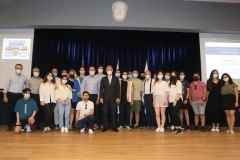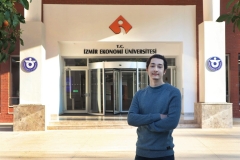
VOCATIONAL SCHOOL
Department of Graphic Design (Turkish)
MGT 227 | Course Introduction and Application Information
| Course Name |
Recent Approaches in Graphics
|
|
Code
|
Semester
|
Theory
(hour/week) |
Application/Lab
(hour/week) |
Local Credits
|
ECTS
|
|
MGT 227
|
Fall/Spring
|
3
|
0
|
3
|
3
|
| Prerequisites |
None
|
|||||
| Course Language |
Turkish
|
|||||
| Course Type |
Elective
|
|||||
| Course Level |
Short Cycle
|
|||||
| Mode of Delivery | - | |||||
| Teaching Methods and Techniques of the Course | Application: Experiment / Laboratory / Workshop | |||||
| Course Coordinator | - | |||||
| Course Lecturer(s) | ||||||
| Assistant(s) | - | |||||
| Course Objectives | Graphic design program has an important relationship with other design areas. Within this course students will be able to experience this relationship and explore new working areas. |
| Learning Outcomes |
The students who succeeded in this course;
|
| Course Description | Information of graphical production software based on visual communication design and necessary infrastructure for technical equipment constitutes the course content. |
|
|
Core Courses | |
| Major Area Courses |
X
|
|
| Supportive Courses | ||
| Media and Management Skills Courses | ||
| Transferable Skill Courses |
WEEKLY SUBJECTS AND RELATED PREPARATION STUDIES
| Week | Subjects | Related Preparation |
| 1 | Introduction to course | Meeting students, informing about the content of the course. |
| 2 | Project 1 Brief / Creative Media | Harris, P. Ambrose, G. (2013). Yaratıcı Tasarımın Temelleri, Literatür Yayıncılık. Bölüm: 1 |
| 3 | Idea research / Draft creation | Resource research |
| 4 | Digital application | Composition designs and digital application |
| 5 | Project 1 Deadline / Project 2 Brief / Turkish Graphic Designers introduction | Harris, P. Ambrose, G. (2013). Yaratıcı Tasarımın Temelleri, Literatür Yayıncılık. Bölüm: 3 |
| 6 | Information gathering and composition studies with research techniques. | Visual and literary source researching |
| 7 | Digital application. | Idea draft and digital implementation |
| 8 | Project 2 Deadline (Midterm Exam) | |
| 9 | Project 3 Brief | Reviewing the Project 3 Brief file |
| 10 | Description of the Problem | Harris, P. Ambrose, G. (2013). Yaratıcı Tasarımın Temelleri, Literatür Yayıncılık. Bölüm: 3 |
| 11 | Data collection | Conducting digital and print resource research |
| 12 | Creativity and Invention | Creating sketch designs. |
| 13 | Finding a Solution | Identifying the design idea on the record. |
| 14 | Application | Completing the digital implementation phase. |
| 15 | Project Evaluation | How to Become an Artist” Jerry Saltz |
| 16 | Final |
| Course Notes/Textbooks | Harris, P. Ambrose, G. (2013). Yaratıcı Tasarımın Temelleri, Literatür Yayıncılık. (Çevirmen : Mehmet Emir Usu) ISBN: 9789750406461 |
| Suggested Readings/Materials |
EVALUATION SYSTEM
| Semester Activities | Number | Weigthing |
| Participation |
1
|
10
|
| Laboratory / Application | ||
| Field Work | ||
| Quizzes / Studio Critiques | ||
| Portfolio | ||
| Homework / Assignments | ||
| Presentation / Jury | ||
| Project |
1
|
90
|
| Seminar / Workshop | ||
| Oral Exams | ||
| Midterm | ||
| Final Exam | ||
| Total |
| Weighting of Semester Activities on the Final Grade |
2
|
100
|
| Weighting of End-of-Semester Activities on the Final Grade | ||
| Total |
ECTS / WORKLOAD TABLE
| Semester Activities | Number | Duration (Hours) | Workload |
|---|---|---|---|
| Theoretical Course Hours (Including exam week: 16 x total hours) |
16
|
3
|
48
|
| Laboratory / Application Hours (Including exam week: '.16.' x total hours) |
16
|
0
|
|
| Study Hours Out of Class |
5
|
2
|
10
|
| Field Work |
0
|
||
| Quizzes / Studio Critiques |
0
|
||
| Portfolio |
0
|
||
| Homework / Assignments |
0
|
||
| Presentation / Jury |
0
|
||
| Project |
1
|
32
|
32
|
| Seminar / Workshop |
0
|
||
| Oral Exam |
0
|
||
| Midterms |
0
|
||
| Final Exam |
0
|
||
| Total |
90
|
COURSE LEARNING OUTCOMES AND PROGRAM QUALIFICATIONS RELATIONSHIP
|
#
|
Program Competencies/Outcomes |
* Contribution Level
|
||||
|
1
|
2
|
3
|
4
|
5
|
||
| 1 | To know problem solving in the field of graphic design, to have an analytical and holistic view |
X | ||||
| 2 | To constantly renew and improve the knowledge and skills which gained in the field of graphic design. To have the principle of lifelong learning. |
X | ||||
| 3 | To improve the design skills by analyzing national and international studies and produced design products. To apply these inferences in their own designs. |
X | ||||
| 4 | Taking responsibility as an individual and as a team member. To work effectively and efficiently in accordance with open minded and collective work. |
|||||
| 5 | To have design awareness and responsibility in their own field. To pass this awareness to all common stakeholders. |
|||||
| 6 | To have a good knowledge of technology in their profession. To try to continuously increase this competence. |
X | ||||
| 7 | As an individual who has been professionally trained in design and art, to have the desire to raise awareness in these matters and to enlighten his/her environment. |
|||||
| 8 | To be conscious of the contribution of his/her work make to the nation. To reflect the feeling of social belonging to his/her work. |
|||||
| 9 | To become a creative and productive artist/designer candidate. |
X | ||||
*1 Lowest, 2 Low, 3 Average, 4 High, 5 Highest
NEWS |ALL NEWS

'Success' formula of the masters
Former CEO of Turkcell and investor Süreyya Ciliv, who held senior positions in high technology companies, met with students at the "Students

'Software and design' camp for 40 students
The "Software and Design Camp", held by Izmir University of Economics (IUE) Vocational School in cooperation with Kuika-Turkey's leading software development platform-

'Digital' mobilization
Izmir University of Economics (IUE) started a 'digital transformation' movement in order for students to improve themselves in this field by not


